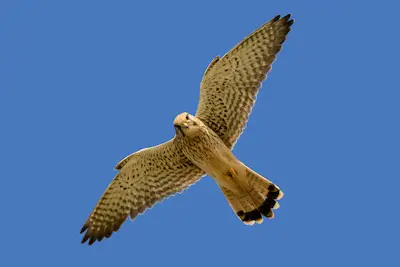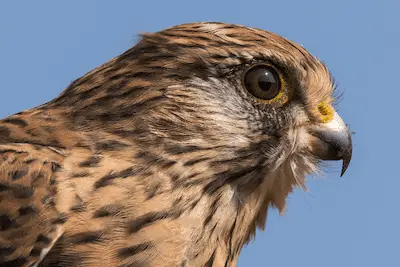Eurasian Kestrel
(Falco tinnunculus)
Also called the Common Kestrel, the Eurasian Kestrel is the most common raptor in Europe after the Common Buzzard.

The reason for this is that the Eurasian Kestrel has adapted relatively well to living in landscapes that are intensively shaped by human activity, and can even be found breeding in large cities.
However, Kestrel populations have been on the decline in some parts of its range, due to the shift from traditional methods of agriculture to modern industrial agriculture.
Because of this, it’s important to monitor the European population of Eurasian Kestrels, and work on providing suitable habitats for them, as doing so will also benefit countless other species.
European Kestrel facts
Due to their relatively high numbers and preference for hunting in open country, Eurasian Kestrels are among the easiest European raptors to observe.
Eurasian Kestrel size
The Eurasian Kestrel is a small falcon that resembles a Eurasian Sparrowhawk in size – smaller than a Wood Pigeon, but larger than a Starling.
- Kestrel wingspan: 67-83 cm
- Length: 32-38 cm
- Weight: 165-290 g
Due to their similar size, Eurasian Kestrel and Sparrowhawks are often confused for each other. However, while a Kestrel has pointed wing tips, the Sparrowhawk has rounded wing tips, which is the easiest way to tell them apart.
Appearance
The overall appearance of the Eurasian Kestrel is that of a small brownish falcon with a long tail. It often hovers over meadows or grassland with its head pointed into the wind, which is perhaps the easiest way to identify it unequivocally.

Sexual dimorphism
Similar to most raptor species, female European Kestrels are larger than males. In addition to this difference, the males also have a distinct coloration. While the females are uniformly light brown with dark brown specks, males have a reddish brown color on top, as well as a light grey head and tail.
Lifespan
The maximum age of the Eurasian Kestrel recorded in captivity is 18 years, while 16 years have been observed in the wild.
Scientific name and taxonomy
The scientific name of the Eurasian Kestrel is Falco tinnunculus. It is thought that there are up to 11 subspecies, of which 3 occur in Europe. Two of these are only found on the Canary Islands, while the nominate species is found everywhere else in Europe.
European Kestrel distribution
Similar to the Eurasian Hobby, Eurasian Kestrels occur all over Europe, except for the northernmost parts of Scandinavia or Iceland.
Outside of Europe, it is found eastwards all the way to the Pacific Ocean and Japan, as well as in large parts of Africa, Central Asia, and some parts of South Eastern Asia. Due to its wide distribution, the Eurasian Kestrel is thought to be the most numerous falcon species on the planet.
Eurasian Kestrel habitat
The Eurasian Kestrel requires open landscapes with grass or low vegetation where it can hunt for rodents and other small animals. It avoids dense forests, but has adapted very well to many landscapes created by humans, including parks, railroad and road embankments, and orchards.
The European Kestrel doesn’t do well in landscapes with intense industrial agriculture, and if it is to survive in areas like that requires fallow zones at the edges. In addition to requiring open landscapes for hunting, the Kestrel also needs suitable nesting opportunities in buildings or in trees.
European Kestrel population size
The European population of the Eurasian Kestrel is estimated to be between 300,000 and 500,000 breeding pairs, which are spread out over many countries, with no single country contributing the lion’s share.
Eurasian Kestrel behavior
The most common behavior of the Eurasian Kestrel behavior that is regularly observed is its hovering at medium height while waiting for rodents to come out their burrows on the ground below. In addition to this hunting technique, it also often hunts from a perch in open country (which is more common during the winter months, as it requires less energy expenditure).
Feeding and diet
The main food source of the Eurasian Kestrel are voles, followed by other small rodents, shrews, insects, reptiles, and young songbirds during the summer months. When breeding in inner cities, Eurasian Kestrels usually fly to open countryside in order to hunt. In southern European populations, insects can constitute the largest part of their diet.
Breeding
Similar to all falcon species, the Eurasian Kestrel doesn’t build its own nest, and requires either hollow spaces (in buildings or trees), or the nests of other birds (such as crows) in order to breed successfully. Since accessible hollow spaces have been largely removed from modern houses, the Eurasian Kestrel benefits greatly from nesting boxes.
The female lays 3-7 eggs, which are incubated for 28-30 days. The number of eggs is closely correlated with the local population size of voles. Similar to the Common Buzzard, the Eurasian Kestrel takes advantage of explosions in the vole population by raising more chicks in these years.
After hatching, young kestrels stay in the nest for up to 32 days, and continue to be fed for several weeks after they fledge.
Migration
The Eurasian Kestrel is a partial migratory bird, with central and southern European populations being largely sedentary (especially adult birds), while northern and eastern European populations are largely migratory, with most individuals traveling to southern Europe in order to spend the winter. Some Eurasian Kestrels also leave Europe and fly thousands of kilometers to spend the winter in Africa south of the Sahara.
European Kestrel conservation status
While the overall population of the European Kestrel appears to be stable (and is classified as “Least Concern” by BirdLife International) it has declined in some parts of its range that have undergone a shift from traditional methods of agriculture to modern industrial agriculture.
And since this shift affects many different species, it’s definitely worth keeping an eye on it, and developing alternative habitats to preserve species like the European Kestrel in landscapes with modern farmland.
Threats
The main threat to the European Kestrel is destruction of habitat due to intensification of agricultural practices. Secondly, the absence of suitable nesting opportunities in modern buildings can also pose a problem.
Fortunately the latter is relatively easy to alleviate by adding nesting boxes to tall buildings or trees (which can also benefit other falcon species, as well as owls).
